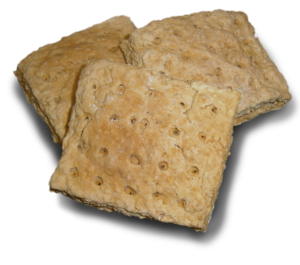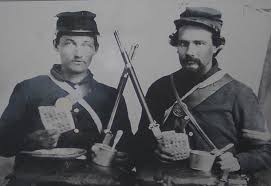What is Hardtack?

The most basic recipe, consisting of just flour and water and a touch of salt, if available, is very hard and lacks taste.
There are other variants that have certain added ingredients that will make your hardtack crunchy, delicious, salty and in most cases, inexpensive – but whatever ingredients are added, hardtack is extremely easy to make.
In fact, it is way more difficult to mess up making hardtack than it is to produce perfect survival rations every time!
Although adding other ingredients to the most basic hardtack recipe will make the biscuits a lot more palatable it will also seriously reduce its shelf life, which, in its unadulterated form, can be an extremely long time, particularly when stored correctly and made without added oils and fats.
The Origins of Hardtack Biscuits
Where did hardtack come from? Despite the fact that their widespread popularization as a survival food and its use in military rations doesn’t date back much further than a few hundred years, the crackers actually date back to the time when processed cereals were first being used for the production of flour.

Because early medical practitioners attributed numerous medical ailments to digestion problems, biscuits or crackers were developed to be as hard as possible, in order to aid with these issues. This is how hardtack was first developed, as bakers knew that even though they were extremely hard, they would soften with time and exposure to humidity.
Hardtack first became widely popularized in the 1500’s and 1600’s as a common ration on British Royal Navy vessels. It later became even more popular with Josiah Bent’s baking operation in 1801, and later when it was produced by machine in Hampshire, England, at the Royal Clarence Victualing Yard.
Bent’s Michigan “water crackers” were also used as an exclusive source of nourishment by gold prospectors in the mid-1800s.
Traditional Use of Hardtack Crackers Worldwide
One of the main qualities of hardtack is that these crackers are remarkably long-lasting. You can make them through simple recipes using only a handful of ingredients, and they won’t go bad for a long time to come, which, when combined with the low cost of the basic ingredients, is precisely why they are regarded as an excellent survival food and also perfect for use as military rations.
In the past, hard tack was taken on long sea voyages and known by names such as cabin bread, ship biscuit, sea biscuit, or pilot bread.

In Asia, variations of hardtack were made particularly popular in Japan and South Korea. Again, as in the US, servicemen used it on a regular basis, and the “dry bread” – as it was called in South Korea – is still being sold as a popular snack in both nations, as well as several other surrounding countries in the Far East.
Another type of hardtack was also a traditional food in Italy. Genoa in particular was one of the places where it was used the most, either on its own or together with fish, and is known as ‘cappon magro‘.
In Russia, hardtack was baked and served with or without adding fat. Russian ‘galeta’ is somewhat softer and usually more crumbly than the kinds of hardtack you’d find in the USA or in other parts of the world, and like almost everywhere else, in Russia, hardtack is still added to soldiers’ military rations.
While hardtack as a survival ration in one form or another is not used everywhere globally, these long-lasting and life saving crackers are still quite prevalent.
If you want to know how to prepare them, you’ll find the ingredients are cheap, easy to find and even easier to put together, and as mentioned earlier, if they are stored correctly can last indefinitely!
How to Make Hardtack
Making hardtack could not be any easier, you definitely don’t need a penchant for cooking that’s for sure! So here’s what you need to make a very basic hardtack?
- 3 cups/390 grams plain white flour
- 2 tsps of salt
- 1 cup/250mls water
- Baking paper, a bowl for mixing, and a knife
1. Start by turning on your oven and preheat it to 375°F/190°C
2. Add the salt and flour together in the bowl.
3. Add the water a little at a time until you achieve a dough that isn’t sticky. It will take a little time to achieve this doughy ball so be patient and keep working it.
4. Once you have your dough you need to flatten it with a rolling pin or something similar. Your dough needs to be between a quarter to one half an inch (6 – 12 mm) thick, any thicker and it takes longer to cook thoroughly. You can shape the rolled dough into a square if you like, it will be easier for cutting up, but it’s not important if you don’t.
5. Cut the rolled dough into 9 squares, or 9 equal pieces
6. Use the tip of the nail to make a holes in each of the sections.
7. Put all the pieces onto a piece of ungreased baking paper and put them into the preheated oven to bake for around 30 minutes.
8. Take out the oven and turn each piece, return to the oven and cook for a further 30 minutes
9. Take the biscuits out of the oven and allow them to cool down.
There is not one oven that cooks exactly the same as the next so you might want to keep an eye on the baking when in progress. You want the biscuit to be slightly browned not burnt so if you need to make slight alterations to what I’ve outlined above then do so.
That’s it!
Once your hardtack has cooled it is good to go, however, if you try to eat them in that form you’ll need strong teeth and jaw muscles as it will be rock hard! If you really want to try one out then do so with a bowl of soup or a cup coffee. When you do, you shouldn’t expect to have your socks blown off by a new flavor sensation.. because it won’t happen!
Do you want to actually see how to make hardtack? Check out the video below.
Although not as tasty as an MRE This great survival food is ideal for stashing away in your emergency gear, or best bug out bag. You could always vacuum seal a few days supply or simply sore it in Ziploc bags ready for use when that emergency situation arises!

